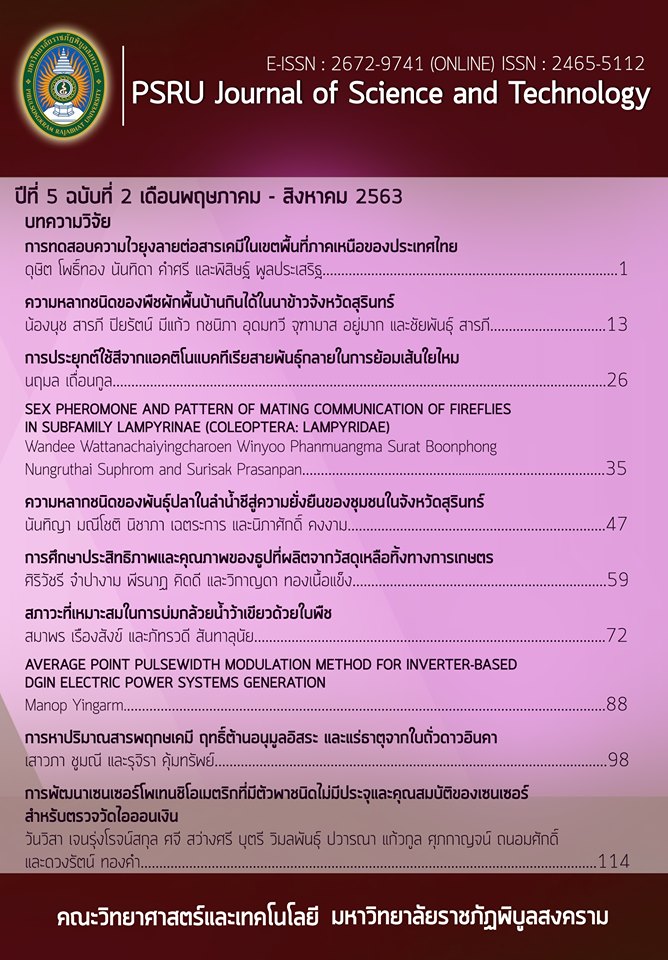THE DETERMINATION OF PHYTOCHEMICAL CONTENT, ANTIOXIDANT ACTIVITY, AND MINERAL FROM THE PLUKENETIA VOLUBILIS L. LEAVES
Keywords:
Sacha inchi leaves, Phytochemical, Antioxidant activity, MineralsAbstract
The objective of this research was determined the amount of phytochemical, antioxidant activity and minerals in Sacha inchi (Plukenetia volubilis L.) leaves at different stages (young, immature and mature leaves). Chlorophyll and carotenoids contents were extracted with 80% acetone and then were measured at 480 510 645 และ 663 nm of absorbance by spectrophotometer. The total phenolic content was analyzed by Folin-Ciocateu method, antioxidant activity was analyzed by DPPH free radical scavenging and minerals were analyzed by Flame Atomic Absorption Spectrophotometer. The results found that fresh-mature leaves in the evening had the highest value of chlorophyll a, chlorophyll b, total of chlorophyll and carotene content were 2.43, 0.91, 3.34 and 1.04 mg/g of fresh leaves, respectively. Fresh-mature leaves had the total phenolic content of 221.46 mgGA/g, antioxidant activity of 2.17 µmol Trolox/g, Ca, Mg and Zn were 616.4, 97.59 and 1.25 mg/100g of fresh leaves, respectively. Mixed immature and mature Sacha inchi tea leaves had the total phenolic content of 1,071.3 mgGA/g, the antioxidant activity of 3.1 µmol Trolox/g and the especially minerals of Ca was highest at 2,035 mg/100g. All of the results showed that both the fresh leaves and the dried leaves of the sacha inchi leaves were nutritious as a health food supplement
References
คงเดช สวาสดิ์พันธ์, ดามรัศมน สุรางกูร, อนุชิต ภานุมาสวิวัฒน์, และภรภัทร สำอางค์. (2563). ฤทธิ์ต้านอนุมูลอิสระและฤทธิ์ยับยั้งเอนไซม์อะซีติลโคลีนเอสเตอเรสของสารสกัดและส่วนสกัดย่อยจากใบตองแตก. PSRU Journal of Science and Technology, 5(1), 107-122.
คณะกรรมการและคณะทำงานปรับปรุงข้อกำหนดสารอาหารที่ควรได้รับประจำวันสำหรับคนไทย. (2563). ปริมาณสารอาหารอ้างอิงที่ควรได้รับประจำวันสำหรับคนไทย พ.ศ. 2563. กรุงเทพฯ: กรมอนามัยสำนักโภชนาการ: กระทรวงสาธารณสุข.
จตุพร ประทุมเทศ, กัลยารัตน์ ทัศน์จันดา, จันทร์สวย เทวสรรเสริญ, รณชัย ภูวันนา, และจารุวรรณ ดรเถื่อน. (2562). การประเมินฤทธิ์ต้านอนุมูลอิสระและปริมาณสารประกอบฟีนอลิกทั้งหมดของชาดอกไม้ชนิดผงปรุงสำเร็จจากกระเจียวแดง อัญชัน และงิ้วป่า. วารสารวิทยาศาสตร์ มข., 47(3), 490-497.
ชานนท์ นัยจิตร, และอนุรักษ์ เชื้อมั่ง. (2559). การประเมินฤทธิ์ต้านอนุมูลอิสระ สารประกอบรวมฟีนอล และ นิโคตินของสมุนไพรไทย 15 ชนิด. Thai Science and Technology Journal, 24(2), 351-361.
ชมพูนุช อุทัยรัตน์, เอกรัฐ ศรีสุข, และกล่าวขวัญ ศรีสุข. (2560). ผลของสภาวะต่างๆ ของการอบแห้งและการสกัดต่อปริมาณของสารประกอบฟีนอลิก สารประกอบฟลาโวนอยด์ และฤทธิ์ต้านอนุมูลอิสระของสารสกัดจากผลปอกะบิด. วารสารวิทยาศาสตร์บูรพา, 22(1), 151-165.
บุหรัน พันธุ์สวรรค์. (2556). อนุมูลอิสระ สารต้านอนุมูลอิสระ และการวิเคราะห์ฤทธิ์ต้านอนุมูลอิสระ. วารสารวิทยาศาสตร์และเทคโนโลยี, 21(3), 275-286.
รักชนก ภูวพัฒน์. (2559). การศึกษาการเปรียบเทียบความสามารถในการผลิตสารทุติยภูมิจาก ใบอ่อน ใบเพสลาด และใบแก่ของถั่วดาวอินคาเพื่อรองรับการผลิตใบชาเพื่อชุมชนของจังหวัดนราธิวาส. Princess of Naradhiwas University Journal, 8(2), 125-133.
ศรินรัตน์ ฉัตรธีระนันท์, วรางคณา สบายใจ, และสิริมาส นิยมไทย. (2556). การทดสอบองค์ประกอบทางพฤกษเคมีและฤทธิ์ต้าน
ออกซิเดชันของใบข่อยดำ. วารสารวิทยาศาสตร์ มข., 41(3), 723-730.
อุดมวิทย์ ไวทยการ, กัญญรัตน์ จำปาทอง, และเถลิงศักดิ์ วีระวุฒิ. (2557). ดาวอินคาพืชมหัศจรรย์สุดยอดโภชนาการ. จดหมายข่าว ผลิใบ ก้าวใหม่การวิจัยและพัฒนาการเกษตร, 17(10), 5-7.
เอนก หาลี, และบุณยกฤต รัตนพันธุ์. (2560). การศึกษาประสิทธิภาพในการต้านอนุมูลอิสระจากพืชผักสมุนไพรพื้นบ้าน 15 ชนิด.
วารสารวิจัยและพัฒนา มจธ., 40(2), 283-293.
อรชร ไอสันเทียะ, และกาญจนา วงศ์กระจ่าง. (2558). การศึกษาระบบตัวทำละลายของการสกัดสารประกอบฟีนอลิก สารประกอบฟลาโวนอยด์ และฤทธิ์ต้านอนุมูลอิสระที่ดีที่สุดจากดอกดาวเรืองสด. วารสารวิชาการวิทยาศาสตร์และเทคโนโลยี มหาวิทยาลัยราชภัฏนครสวรรค์, 7(7), 29-40.
อรเนตร กานต์บุญญา, จำนอง โสมกุล, พิมพ์ชนก สตภูมินทร์, และพรไพรินทร์ รุ่งเจริญทอง. (2019). ศึกษาการพัฒนาผลต่อสารพฤกษเคมีบางชนิดในผลพริกมัน ‘TVRC365’. วารสารเกษตรพระจอมเกล้า, 37(4), 662-668.
AOAC, (2016). Official methods of analysis, Association of official analytical chemist: Method 965.09 sec. 2.06.01. (20th ed.). USA: Washington, D.C..
AOAC, (2016). Official methods of analysis, Association of official analytical chemist: Method 975.03 sec. 3.02.05. (20th ed.). USA: Washington, D.C..
Arnon, DI. (1949). Copper enzymes in isolated chloroplasts polyphenol oxidase in Beta vulgaris. Plant physiol, 24(1), 1-15.
Brand-Williams, W., Cuvelier, ME. & Berset, C. (1995). Use of a free radical method to evaluate antioxidant activity. LWT-Food science and Technology, 28(1), 25–30.
Chirinos, R., Zuloeta, G., Pedreschi, R., Mignolet, E., Larondelle, Y., & Campos, D. (2013). Sacha inchi (Plukenetia volubilis): A seed source of polyunsaturated fatty acids, tocopherols, phytosterols, phenolic compounds and antioxidant capacity. Food chemistry, 141(3), 1732-1739.
Fanali, C., Dugo, L., Cacciola, F., Beccaria, M., Grasso, S., Dacha, M., & Mondello, L. (2011). Chemical characterization of sacha Inchi (Plukenetia volubilis L.) oil. Journal of agricultural and food chemistry, 59(24), 13043-13049.
Fernandes, R.D.P.P., Trindade, M.A., Tonin, F.G., Lima, C.G.D., Pugine, S.M.P., Munekata, P.E.S., & De Melo, M.P. (2016). Evaluation of antioxidant capacity of 13 plant extracts by three different methods: cluster analyses applied for selection of the natural extracts with higher antioxidant capacity to replace synthetic antioxidant in lamb burgers. Journal of food science and technology, 53(1), 451-460.
Garmendia, F., Pando, R., & Ronceros, G. (2011). Effect of sacha inchi oil (Plukenetia volubilis L.) on the lipid profile of patients with hyperlipoproteinemia. Revista peruana de medicina experimental y salud publica, 28(4), 628-632.
Gogoi, M., & Basumatary, M. (2018). Estimation of the chlorophyll concentration in seven citrus species of Kokrajhar district, BTAD, Assam, India. Trop Plant Res, 5, 83-87.
Gutiérrez, L.F., Rosada, L.M., & Jiménez, Á. (2011). Chemical composition of sacha inchi (Plukenetia volubilis L.) seeds and characteristics of their lipid fraction. Grasas y aceites, 62(1), 76-83.
Kamble, P.N., Giri, S.P., Mane, R.S., & Tiwana, A. (2015). Estimation of chlorophyll content in young and adult leaves of some selected plants. Universal journal of environmental research and technology, 6, 306-310.
Hamaker, B.R., Valles, C., Gilman, R., Hardmeier, R.M., Clark, D., Garcia, H.H., & Rodriguez, T. (1992). Amino acid and fatty acid profiles of the inca peanut (Plukenetia volubilis). Cereal chem, 69(4), 461-463.
Momin, R.K., & Kadam, V.B. (2011). Biochemical analysis of leaves of some medicinal plants of genus Sesbania. Journal of Ecobiotechnology, 3(2), 14-16.
Nascimento, A.K.L., Melo-Silveira, R.F., Dantas-Santos, N., Fernandes, J.M., Zucolotto, S.M., Rocha, H.A.O., & Scortecci, K.C. (2013). Antioxidant and antiproliferative activities of leaf extracts from Plukenetia volubilis Linneo (Euphorbiaceae). Evidence-Based Complementary and Alternative Medicine, 2013, 1-10.
Rajput, R.D., & Patil, R.P. (2017). The comparative study on spectrophotometric analysis of chlorophyll and carotenoids pigments from non-leguminous fodder crops. International Journal of Innovative Science Engineering and Technology, 7, 140-148.
Singleton, V.L., Orthofer, R., & Lamuela-Raventós, R.M. (1999). Analysis of total phenols and other oxidation substrates and antioxidants by means of folin-ciocalteu reagent. Methods in enzymology, 299, 152-178.
Wang S, Zhu F, & Kakuda Y. (2018). Sacha inchi (Plukenetia volubilis L.): Nutritional composition, biological activity, and uses. Food chem, 265, 316-328.
Downloads
Published
How to Cite
Issue
Section
License
กองบรรณาธิการขอสงวนสิทธิ์ในการปรับปรุงแก้ไขตัวอักษรและคำสะกดต่างๆ ที่ไม่ถูกต้อง และต้นฉบับที่ได้รับการตีพิมพ์ในวารสาร PSRU Journal of Science and Technology ถือเป็นกรรมสิทธิ์ของคณะวิทยาศาสตร์และเทคโนโลยี มหาวิทยาลัยราชภัฏพิบูลสงคราม และ
ผลการพิจารณาคัดเลือกบทความตีพิมพ์ในวารสารให้ถือมติของกองบรรณาธิการเป็นที่สิ้นสุด







